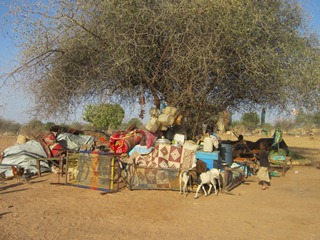UNHCR shifting Darfur IDPs to safer areas inside Chad
April 26, 2013 (KHARTOUM) – The United Nations refugee agency (UNHCR) has started moving thousands of displaced Sudanese civilians who fled across the border from violence in Darfur to safer areas further inside Chad.

The refugee agency says it has now started moving thousands of civilians, mainly women and children, to camps deeper inside Chad as a safety precaution.
“As a security measure, UNHCR is relocating 5,000 of them [refugees] to the Goz Amer camp [about 230 kilometres to the north] where we can better provide them with protection and assistance,” said Aminata Gueye, UNHCR’s representative in Chad. She added that a new camp for 25,000 people may be constructed at Sterena, 25kms north of Goz Beida, the largest town in the south-east.
The numbers of displaced civilians arriving in south-east Chad have increased in recent weeks as tribal conflict escalated across the border in Um Dukhun.
UNHCR has set up a temporary office in Tissi and is monitoring new arrivals along a 60-kilometre stretch of the border in conjunction with Chadian authorities.
The agency has also deployed experts in water, sanitation and hygiene, as well as protection, registration and logistics officers.
Conditions at Tissi remain harsh, with many of the newly-arrived refugees taking shelter from the elements under trees, having been provided only limited assistance.
“Under every tree, there is a family,” explained Abdellahi Ould El Bah, UNHCR’s emergency coordinator in Tissi in a statement on Tuesday. “The refugees are exposed to the wind and sun during the day and are cold at night,” he said, adding that many did not even have blankets.
Climatic extremes add to the difficulties faced by new arrivals at the makeshift camp, said the UNHCR, with temperatures in the semi-arid region soaring during the day before dipping under 20 degrees Celsius at night.
SITUATION PRECARIOUS
Medecins Sans Frontières (MSF), which is in the area treating the wounded, said the humanitarian situation remained precarious, with refugees having almost no access to food or clean drinkable water.
“Their situation is extremely precarious and it is urgent that other humanitarian actors in Chad rapidly move to organise distributions of food and non-food items”, Alexandre Morhain, MSF’s head of mission in Chad, said in a statement earlier this month.
The impending rainy season added an even greater urgency to the situation on the ground, said Morhain.
“We need to act now, because within two months it will be impossible to access this area by road”, he said.
Morhain says MSF teams are also working to contain an outbreak of measles in a nearby area, which has already killed seven children, five of whom were under five years old.
He said MSF plans to launch an emergency measles vaccination campaign in cooperation with the Chadian ministry of public health covering the entire Tissi area and will also treat severe acute malnutrition cases and paediatric emergencies.
TRIBAL FIGHTING
The influx of displaced civilians to Tissi was triggered after fierce fighting erupted in early March between the Salamat and Misseriya tribes in and around the Um Dukhun after an attempted armed robbery.
Speaking to journalists in Geneva earlier this month, UNHCR spokesperson Melissa Fleming said many of the new arrivals were “exhausted, traumatised and visibly disturbed.”
“Refugees witnessed their houses being destroyed and villages completely burnt down. Many reported their relatives being killed in the latest round of violence,” she said.
Thirty-year-old Khadjidja told UNHCR that she had abandoned her possessions and fled across the border with her three children after her village was attacked. She arrived with almost nothing.
“We left our village when it was torched and looted,” she told the UNHCR, adding that it took two days to walk to Tissi. “My husband stayed behind to save some of our belongings before joining us”, she added.
UNHCR said some new arrivals had been taken in by generous host communities in the Tissi area, but concedes the high numbers of displaced is straining resources.
El Bah said some refugees had been drinking from a river, putting themselves at risk of catching waterborne diseases.
Since mid-April, three UNHCR convoys have taken about 600 people to the Goz Amer camp. The trucks are also transporting the few belongings that people were able to bring with them.
On arrival in Goz Amer, the refugees are given a monthly dry food ration by the World Food Programme (WFP), with a kitty of non-food items provided by the UNHCR, including mosquito nets, jerry cans, blankets, soap and kitchen sets. New shelters have also been constructed for the arriving families, with a water distribution network to be extended to new camp areas.
A spate of violence between various groups across Darfur in recent weeks has seen at least 50,000 people flee to Chad, with the UNHCR calling it the largest influx from Darfur since 2005.
Some 300,000 Sudanese refugees have fled to Chad to escape violence in war-torn Darfur during the 10-year conflict.
The majority are reluctant to return home due to ongoing instability in the troubled region.
(ST)
